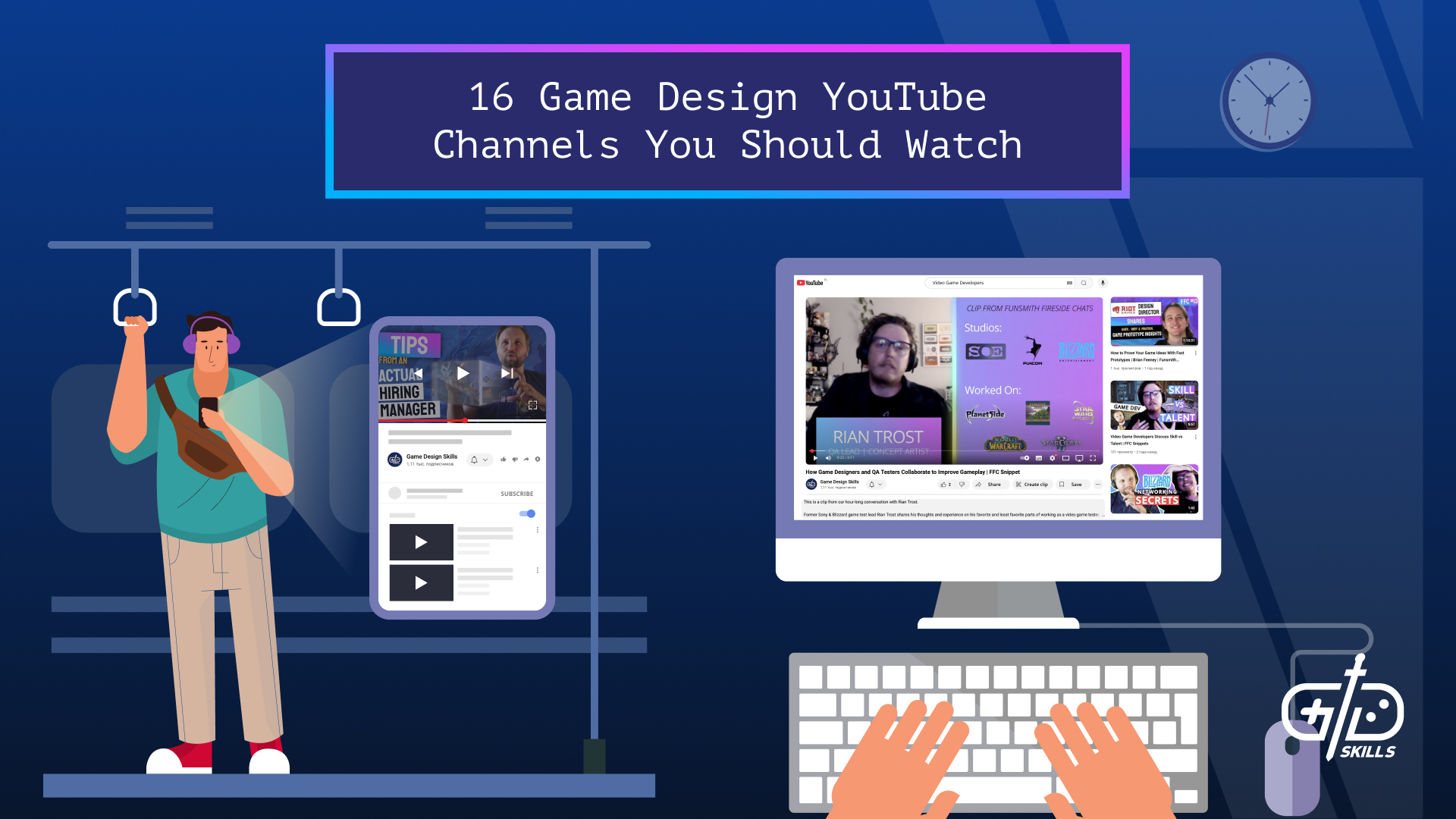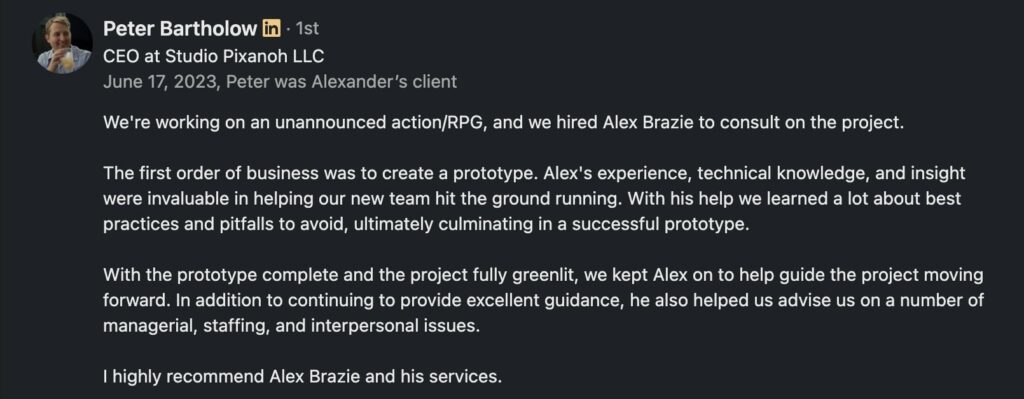Game design YouTube channels help aspiring and experienced video game designers share ideas, connect with working professionals, and push the craft of game design forward. YouTube’s video format allows designers to discuss their choices, practices, and tools while giving visual examples from popular games and series.
The YouTube game design niche has exploded in recent years, so I made this list to highlight some of the best channels. I’ve included channels covering indie, AA, and AAA titles. Subjects covered on these channels are a mix of tutorial, discussion, and advice. Keep reading to learn about the top sixteen game design channels on YouTube and why they’re worth listening to.
1. Game Design Skills
Game Design Skills (GDS) was founded by Alexander Brazie, a game designer who’s worked on titles like World of Warcraft (WoW), Ori and the Will of the Wisps, and League of Legends (LoL). Alex started Game Design Skills in 2016 to share his design insights on topics like mechanics, in-game economies, character design, career progression, and more. The site has grown to include articles by other contributors such as Nathan Kellerman (level design), Kelly Bender and John Ryan (narrative design), and many more.
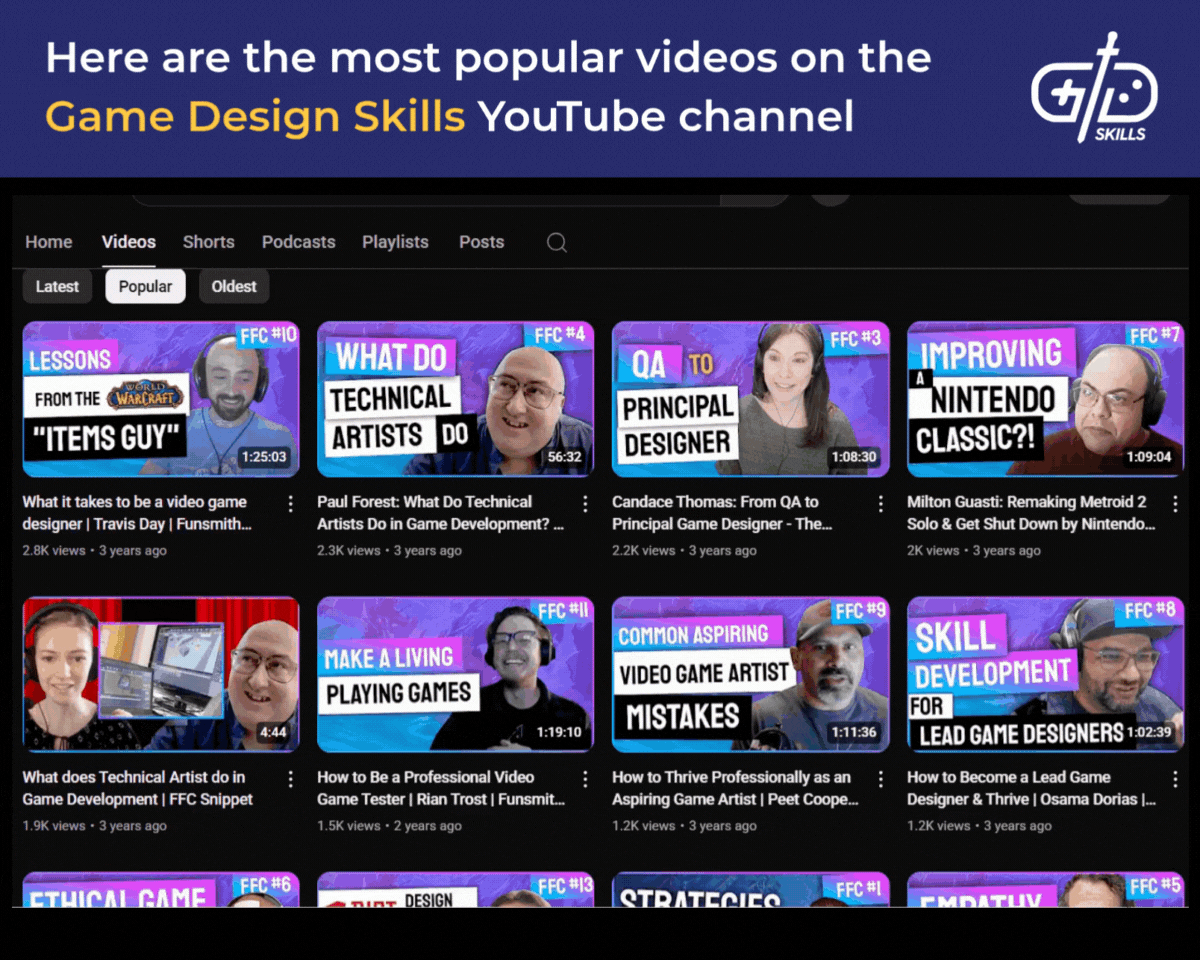
Watch GDS for its practice-led approach. Both GDS’s online content and optional paid courses feature real actionable advice with examples. Advice, tips, and techniques are never given in the abstract, with instructors and interviewees reflecting on their design work through real, tangible examples – often referencing games the audience are familiar with. Previous podcast guests have included Brian Feeney (Riot Games), Peet Cooper (former Blizzard and Riot), and Paul Forest (Amazon Games). GDS’s large, responsive Discord community, huge library of wiki posts, and roster of industry-leading instructors and contributors make it worth checking out.
The GDS YouTube account currently hosts 13 episodes of its Funsmith Fireside Chats podcast. The website’s article library is more extensive with written guides and wikis covering every aspect of game design. Game Design Skills’ audience is modest compared to some of the largest channels. However, Game Design Skills’ resources are regularly accessed by junior to senior level devs at studios like EA, Bethesda, Riot, Blizzard, and Ubisoft. Game Design Skills monetize through bootcamps taught by industry professionals, focused on deliverable portfolio pieces and actionable frameworks.
2. Game Maker’s Toolkit
The Game Maker’s Toolkit (GMTK) was created by its host, game journalist and designer, Mark Brown, in 2014. Brown contributed to publications like Edge, Polygon, and Pocket Gamer before launching the channel. GMTK’s format is deep-dive YouTube essays on design topics like accessibility, UI, level design, and more. GMTK offers educational tools like its Platformer Toolkit on itch.io to complement its instructional video content. An annual GMTK game jam hosted on itch.io attracts tens of thousands of participants and produces thousands of games.
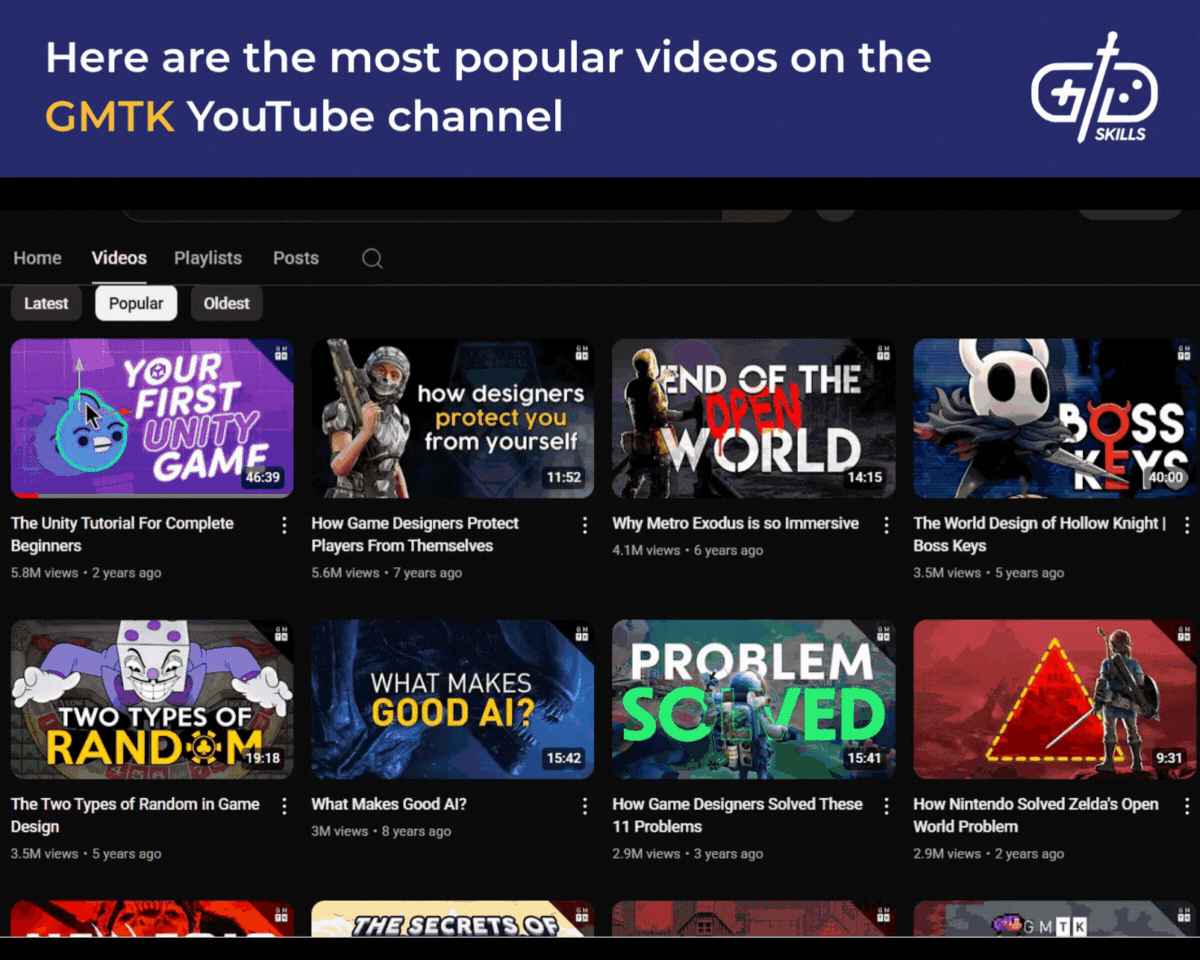
GMTK’s analysis is nuanced, looking at design choices as a series of trade offs rather than a black and white good vs bad paradigm. The host’s background as a journalist means he presents material in an entertaining way, while still diving deep into every aspect of the game design process. GMTK focuses on what works, but also explores what may have been sacrificed to achieve it. The analysis is thoughtful, well put together, and uses examples from games familiar to the audience. The community element and game jams make it more than just a channel.
GMTK’s current library sits at over 200 videos on a broad range of topics and genres. The channel’s subscriber count is over 1.6 million, and the total number of channel views is over 200 million. GMTK game jams are massive events, regularly hosting over 30 thousand participants and producing 10 thousand games. GMTK is monetized through YouTube ad sharing, Patreon, affiliate links, and sometimes merchandise. Host, Mark Brown produces and sells his own games, with his design series acting as advertisement.
3. GDC
The Game Developers Conference (GDC) is an annual gathering of games industry professionals including designers, developers, artists, producers, business people, and more. The GDC started as The Computer Game Developers Conference and was first hosted by designer Chris Crawford in his San Jose living room in 1988. The GDC hosts panels, roundtable discussions, lectures, and tutorials on every aspect of the video game creation. The Independent Games Festival and Game Developers Choice award are a part of the GDC ecosystem, recognizing the work of the broader game development community annually.
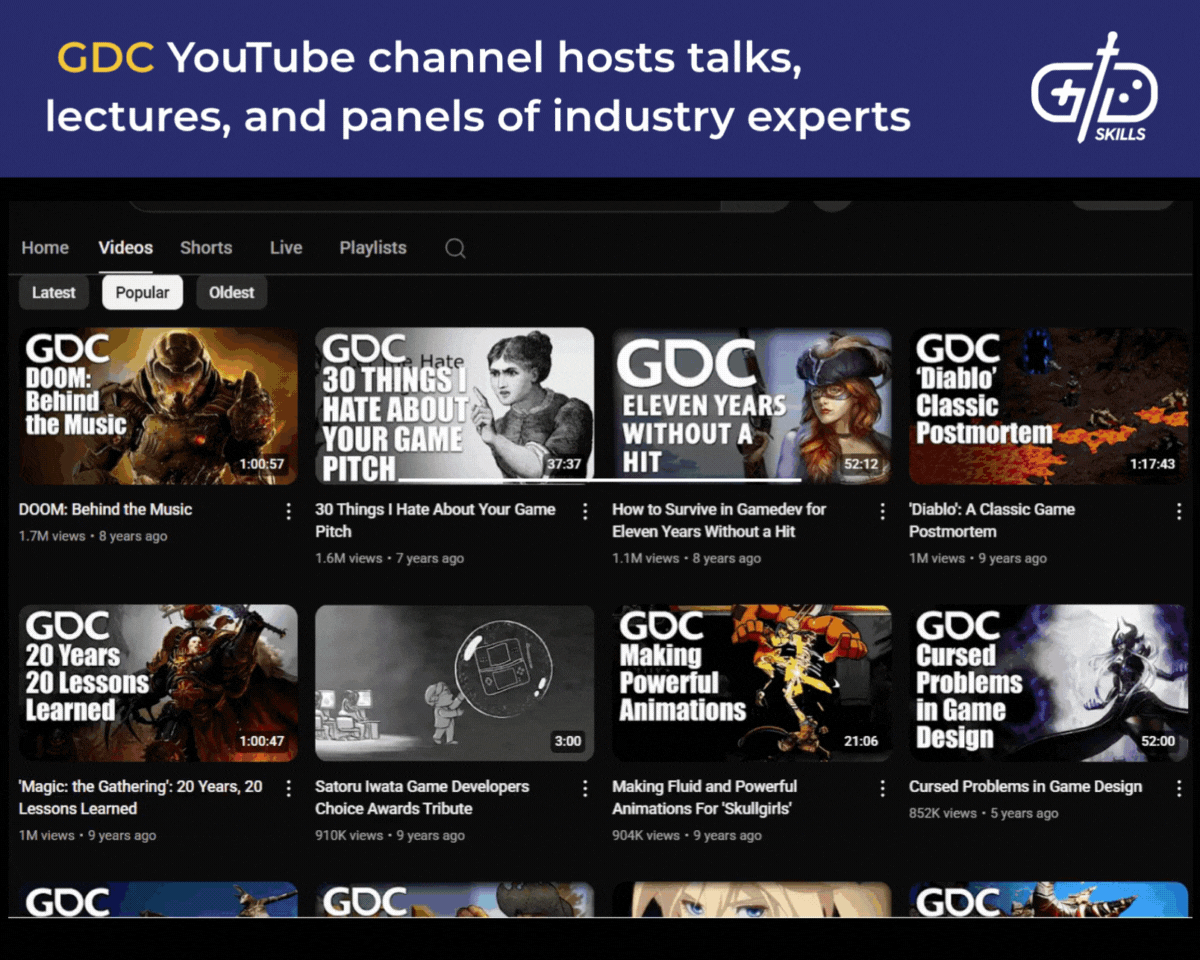
The GDC channel on YouTube hosts talks, panels, and discussions from previous years’ GDC talks. These videos contain industry experts discussing past projects and future ambitions, offering insight into the practices of people working in the game development field. A highlight in the vault is Jonas Bötel’s Subnautica Postmortem, where he discusses how the dev team almost went bankrupt before saving Subnautica through community feedback and open development.
The GDC YouTube channel is worth watching for its developer-led deep dives into design and development. Each talk is presented by someone with hands-on experience and knowledge to share. The GDC conference, where the talks are presented, is a well-regarded-, well-attended industry event. Speakers prepare their most interesting stories and compelling analysis to make a good impression on their peers. The result for the rest of us tuning into the GDC channel is a library of engaging videos discussing some of the most popular games of our time. The GDC channel acts as an advertisement for the ticketed, in-person annual event. Premium access to the GDC vault unlocks more video content for a fee.
4. Brackeys
Brackeys is a YouTube channel hosted by Asbjørn Thirslund started in 2012. Brackeys was initially known for its Unity tutorials, but has broadened the scope to include all aspects of game design and development. Brackeys publishes regular tutorial content around programming, scripting, visual tools, and tips, and tricks. The channel features content on making games from scratch and the associated website includes tutorials, resources, and an active community.
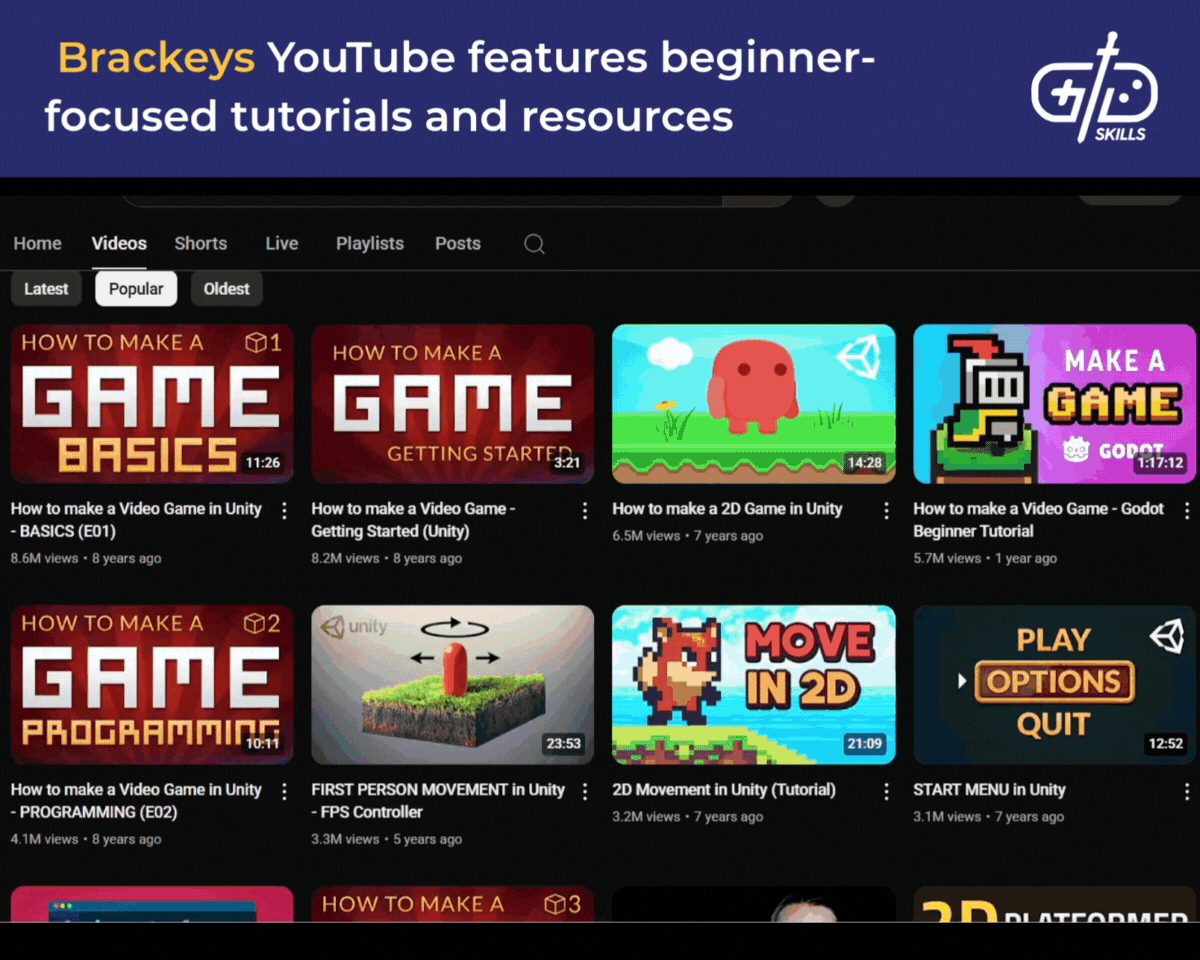
Watch Brackeys for its beginner to intermediate-friendly tutorial content that’s backed up by resources and community feedback. High-quality, easy-to-understand lessons like those on Brackeys’ channel are uncommon outside of paid content. Thirslund makes the process accessible while at the same time including insights that more experienced devs appreciate. The entire library of content is free to access, making Brackeys an easy bookmark for beginner and intermediate devs.
Brackeys has over 450 videos on its YouTube channel which boasts 1.9 million subscribers. Videos routinely get views in excess of hundreds of thousands. Brackeys took a break from producing content in 2020, but changes to Unity’s licensing model saw renewed channel activity. All Brackeys’ video content is free, with revenue likely coming from ad-sharing. The website contains links to a PayPal donation page and optional, paid High Quality assets are available alongside the free-to-use options.
5. Extra Credits
Extra Credits was created by Daniel Floyd and Alex Portnow, first appearing as part of an academic assignment by Floyd in 2008. Extra Credits focus on animated videos about game design principles, mechanics, and community management, but also examine related topics like mythology, history, literature, and world-building. The show has previously been a part of The Escapist and Penny Arcade TV before finding its home on YouTube. Extra Credits original hosts have stepped back from the project and it’s now presented by Matt Krol and Geoffrey Zatkin.
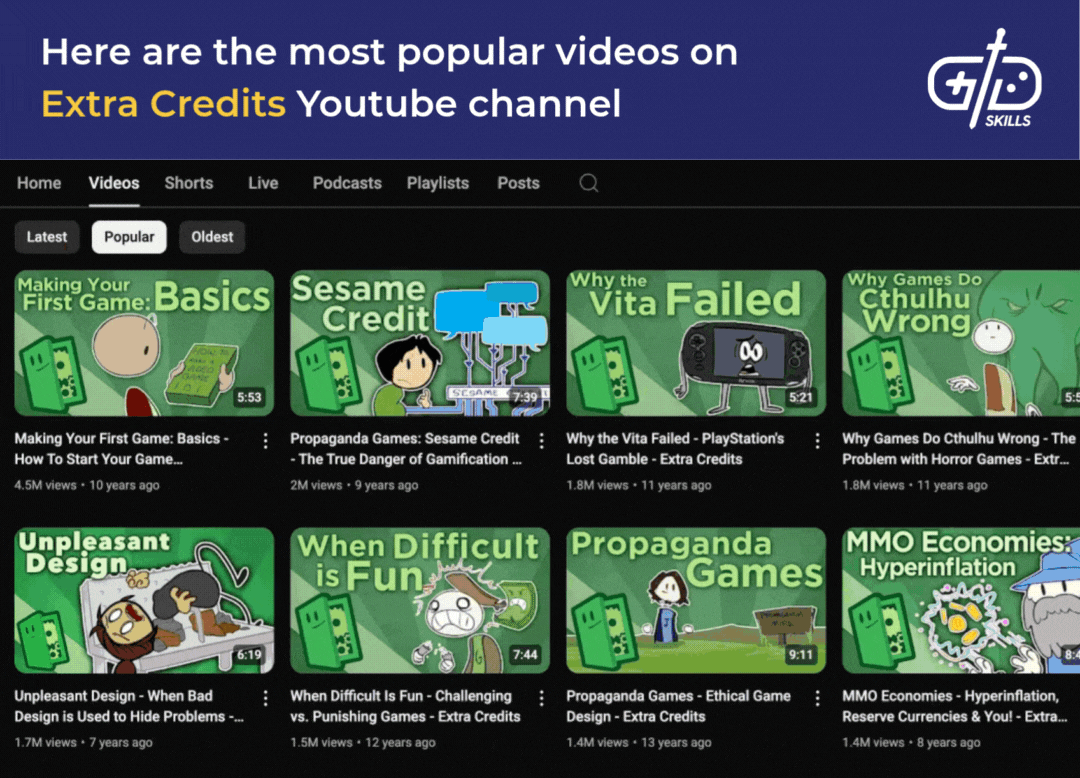
Extra Credits have been producing game design video content since 2008 and have honed their production and presentation skills in that time. The channel’s output is consistent, easy-to-follow, and dives into the diverse topics that influence gaming culture like historical conflicts, mythical creatures, tabletop influences, literature, and sci-fi and fantasy. Extra Credits publish content on how to make games, but also ask questions around the culture and meaning of gaming in a broader context. Designers and developers enjoy the channel, but critically minded gamers also find a lot to like.
There are over one thousand long form episodes and one thousand five hundred animated shorts on the Extra Credits channel. Extra Credits currently has more than 3.5 million subscribers with videos often racking up hundreds of thousands of views. The channel is supported by YouTube ad revenue, merchandise, and Patreon membership. Members get early access to videos and get to vote on future topics to be covered in the series.
6. Jonas Tyroller
Jonas Tyroller is a German indie developer and content creator who hosts a YouTube channel publishing educational game dev content. Tyroller has co-developed several projects including Islanders, Will You Snail?, and Thronefall. He started documenting his own projects and sharing educational videos on YouTube in 2018. The channel is a mix of theory, tutorials, and advice, covering a broad range of topics from marketing to project planning.
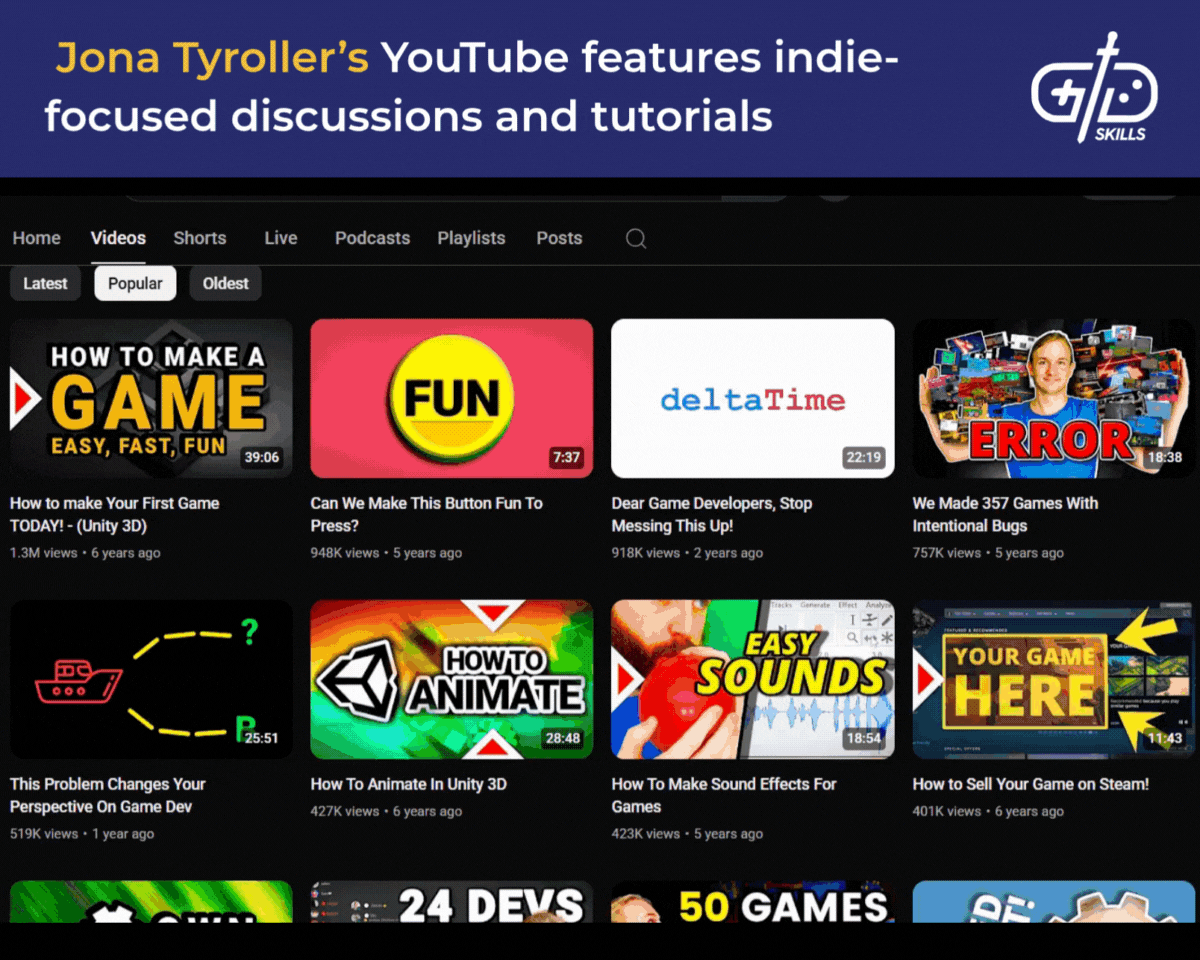
Tyroller’s content appeals to indie devs because Jonas is a successful indie game maker who ships games and makes content. He’s used to working with the small teams and technical constraints of indie development and knows how to distill his experience into advice. Watching the entire process from ideation to polished, shippable product is useful for first time and experienced devs.
Jonas Tyroller’s YouTube channel currently has over two hundred and fifty videos with over twenty one million views. The subscriber count is over two hundred thousand. Jonas’s high viewer count means he likely makes YouTube ad revenue. His videos act as a kind of advertising for his commercially released projects like Thronefall.
7. AI and Games
AI and Games is a YouTube channel created by Dr Tommy Thompson in 2014 to offer insight into how AI is used in video games. The channel features retrospectives on games with standout or otherwise interesting AI systems. An Alien: Isolation retrospective analyzes the xenomorph’s behaviour in that game, for example. Other examples include the AI of Doom and analysis of Halo and Sea of Thieves.
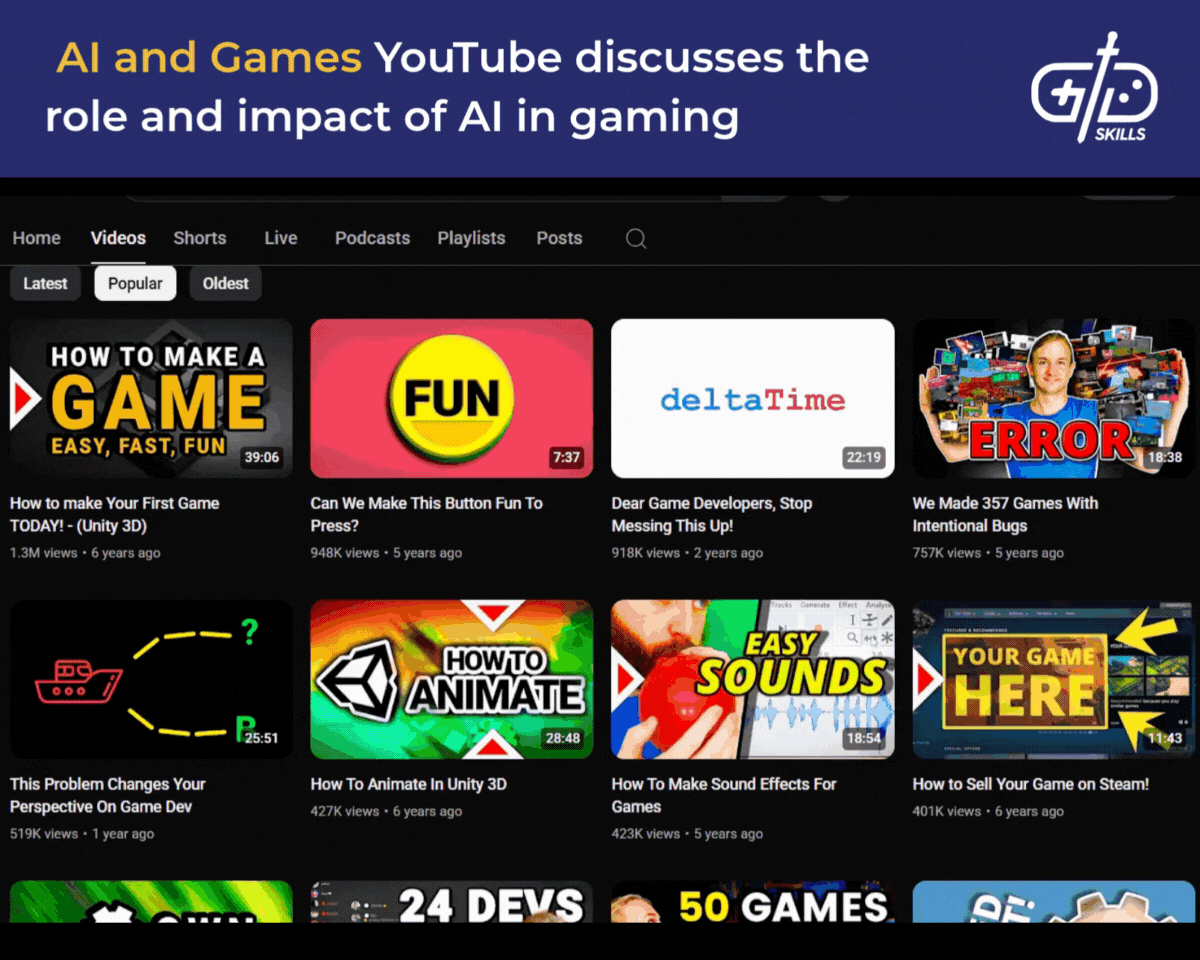
AI and Games offers insight into the why of enemy and NPC behaviour in games. Aspiring devs who want to look under the hood to understand how AI shapes the feel of a game enjoy this channel. Thompson has published over fifty peer-reviewed works in the field of machine learning for games, so understands the intricacies of the subject and how it directly applies to this medium. Dr Thompson maintains an approachable tone to his videos, despite his academic background.
With over one hundred and seventy videos on the channel, AI and Games offers insight into the AI systems underpinning many genres. More than ten million people have tuned in for the channel’s advice. The roughly fifteen minute long videos are conveniently short. AI and Games accepts channel sponsorship deals and founder Dr Tommy Thompson offers consultancy and connects with his audience through a regular newsletter.
8. Code Monkey
Code Monkey is a YouTube channel focused on making C# and Unity tutorial content for over a decade. Code Monkey covers detailed tutorials on C#, beginner Unity lessons, asset reviews, and game dev reports covering various aspects of the video game industry. The channel regularly covers free assets, tools, and systems, making it a good choice for solo or indie development teams.
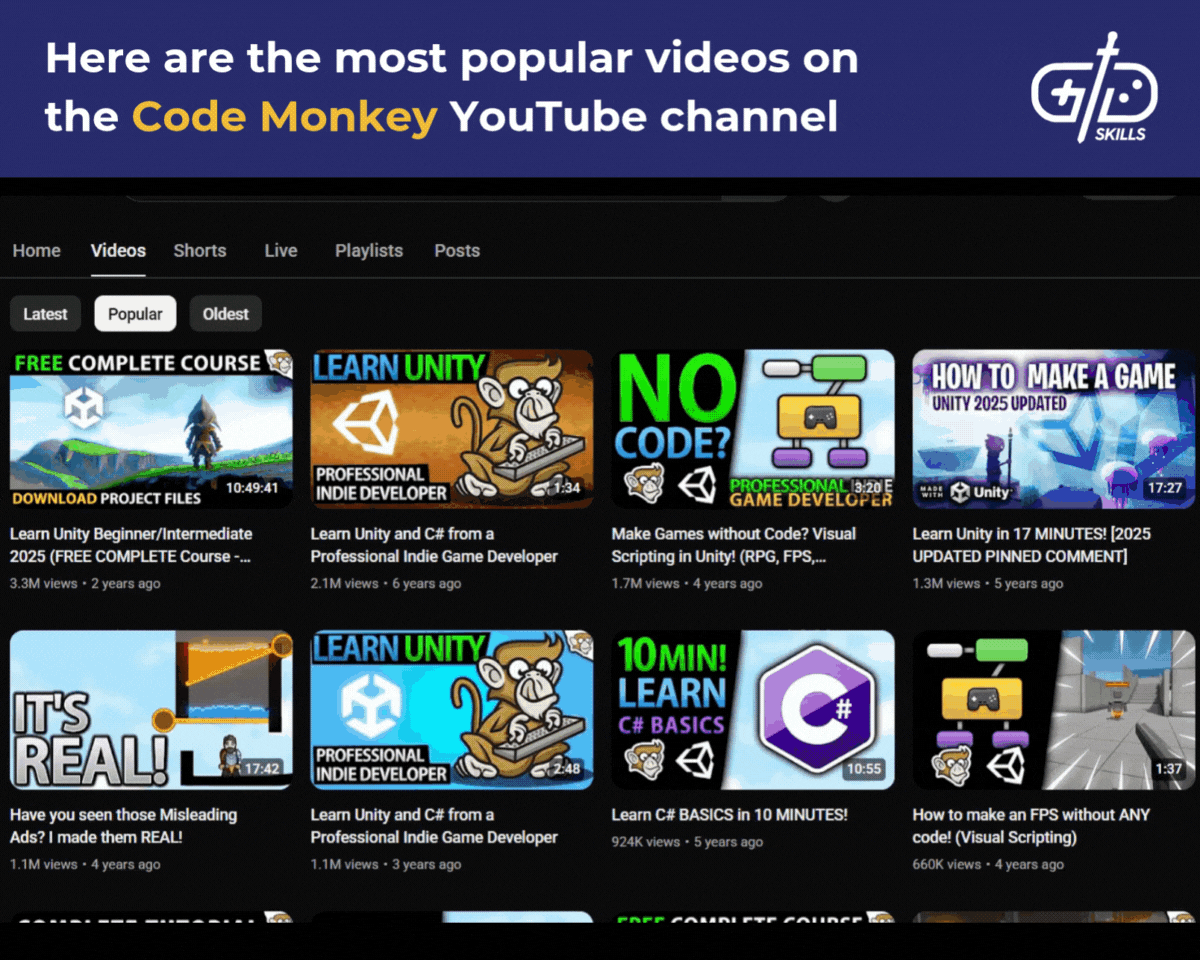
Code Monkey’s is an alias for a solo dev with 9 published games on Steam. They share clear, focused tutorials on how to make a game from the ground up in C# and Unity. Code Monkey’s experience and shipped games means they teach from the basics right up to complex systems. The YouTube library is complemented by free online learning resources from Code Monkey’s website.
The Code Monkey channel has over one thousand two hundred videos and over five hundred thousand subscribers. Endless Loop Studios are part of the Code Monkey ecosystem. Bundles of Endless Loop Studios games are available on the Code Monkey website, and the channel videos sometimes act as indirect advertising for those games. The courses on the Code Monkey website are a mix of free and paid. The Code Monkey YouTube channel acts as a funnel for these high-quality courses.
9. The Cherno
The Cherno is a YouTube channel created in 2012 by Yan Chernikov, a developer focused on C++, game engines, and software engineering. Chernikov was previously a software engineer at EA. He created his own engine, called the Hazel Engine, which features in some of his videos. The Cherno covers topics like C++ programming, graphics programming, and code reviews. Reactions to new tools, engine demos, and technologies are also common.
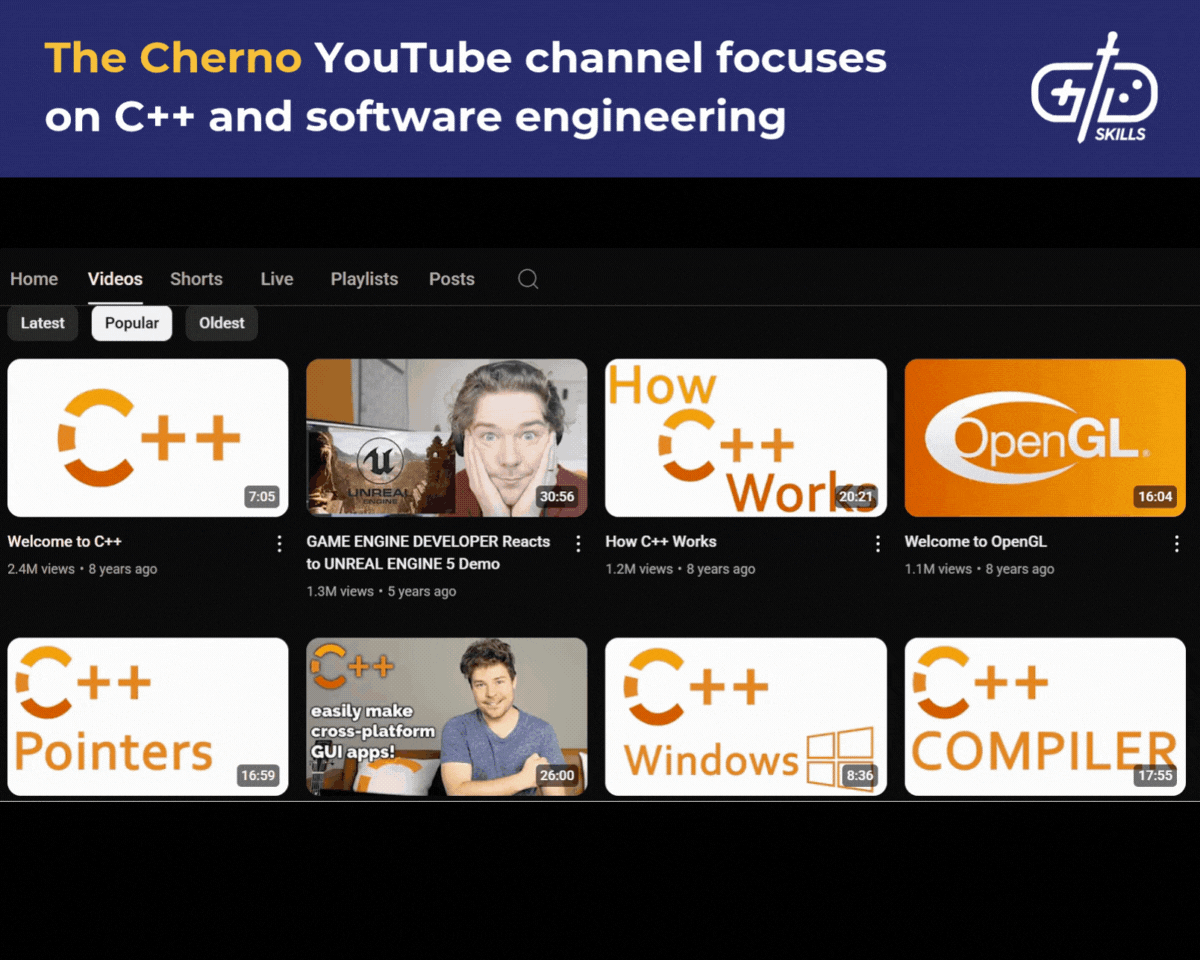
The Cherno provides deep technical insight into the process of building a game engine. The channel is useful for developers and designers who want to understand how things like architecture, rendering, and performance are achieved under the hood. Cherno mixes tutorials, theory, and actual, real time code development. It’s interesting to see how his projects evolve over time and why he makes certain choices. The audience often only see the finished product in game dev. The Cherno’s channel offers a rare insight into the entire process from an over-the-shoulder view.
Over eight hundred instructionals, tutorials, and deep dive videos are available on The Cherno YouTube account. With over seven hundred thousand subscribers, the channel’s videos have been viewed more than eighty million times. The Cherno’s large subscriber count means YouTube ad revenue is a likely source of income.
10. Design Doc
Design Docs is a YouTube channel created by brothers Mike and Dan. Dan created the channel as part of his thesis project in 2008, but serious views and online traction didn’t begin until 2016. Design Docs focus on video essays analyzing specific design choices and how small decisions build up to create cohesive experiences. Regular topics include UI, mission design, level design, boss encounters, mechanics, and pacing. The videos tackle one topic per view and dive deep into the decisions around the chosen subject.
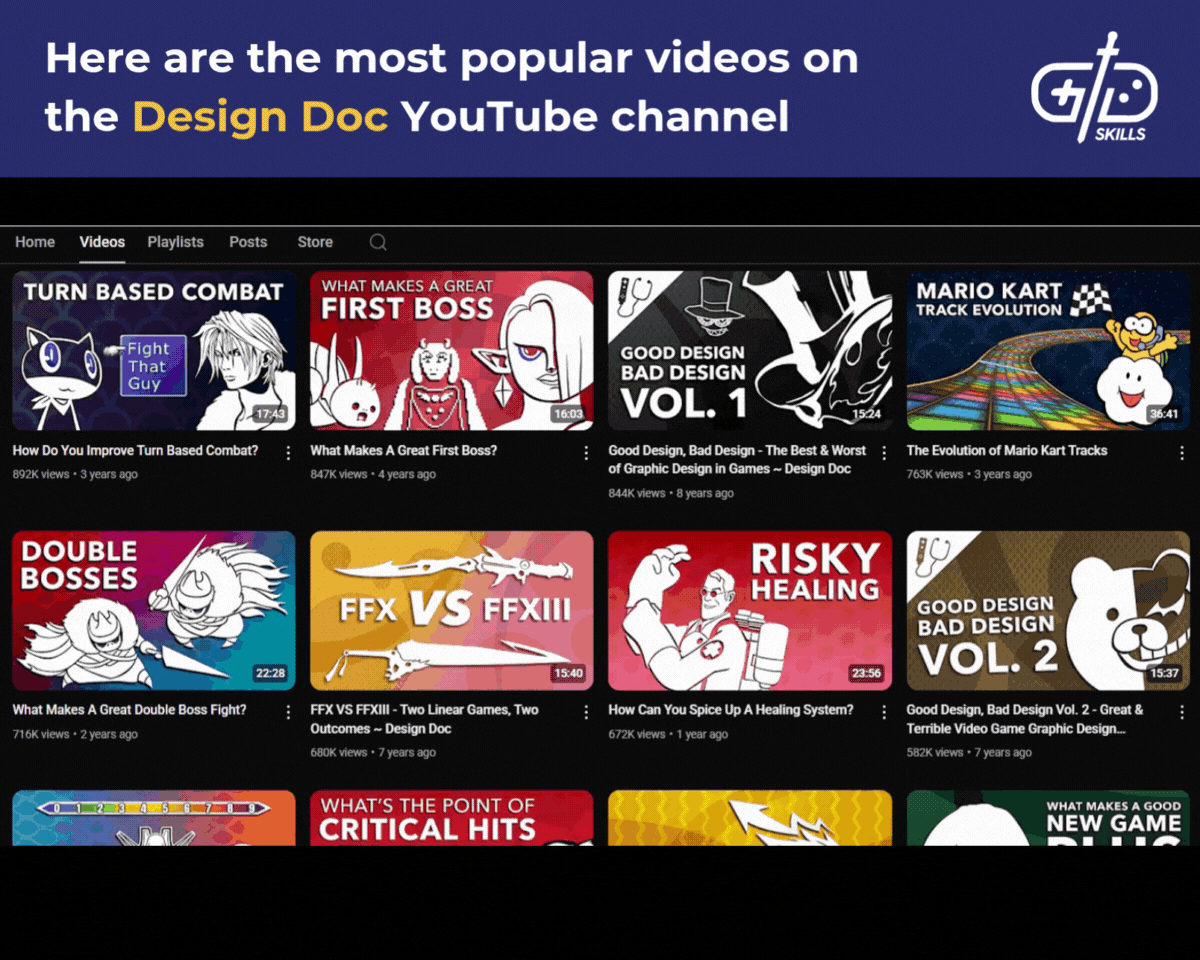
Watch Design Docs for its concise but detailed analysis of how small design choices intersect and overlap. Mike and Dan drill deep into their chosen topics, helping viewers to think like designers. Design choices are analyzed as a series of tradeoffs rather than simple binary choices, helping aspiring designers to think critically. Design Docs videos presentation and pacing are top notch, making it easy for even casual viewers to follow.
Design Docs currently have over one hundred and thirty videos on their channel that have amassed over thirty six million views. The channel’s subscriber count is over three hundred and sixty thousand. Design Docs likely makes revenue from ad sharing given the channel’s size. A Patreon also supports the channel’s efforts.
11. GDQuest
GDQuest was created by Nathan Lovato in 2015 to support learning and training in the open source Godot engine. The channel and project includes a team of developer and tutorial creators whose mission is to teach game development using open source and free tools (with a focus on Godot and associated tools). The channel’s tutorials focus on tutorials covering every aspect of the Godot engine from GDScript to AI to optimization.
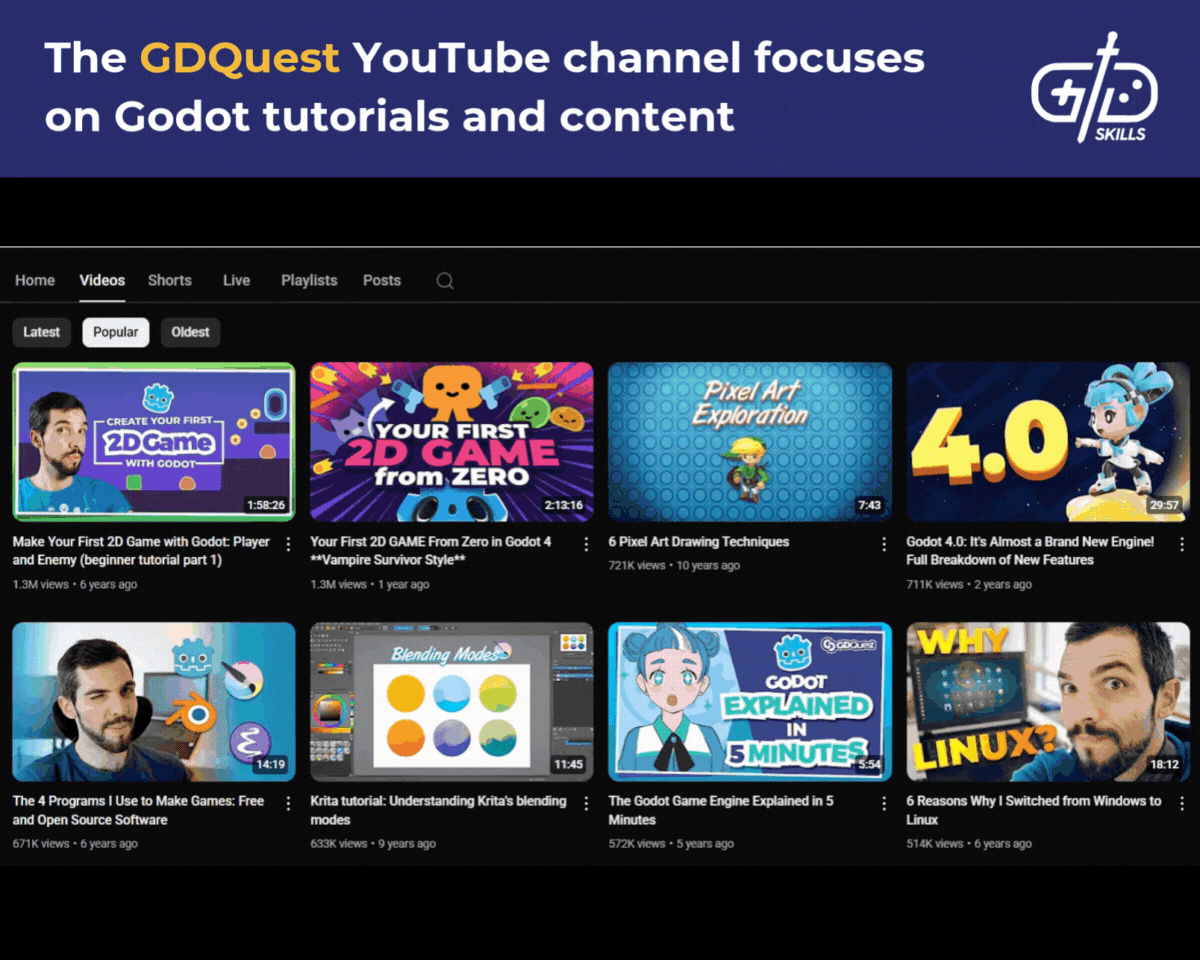
Watch GDQuest for its singular focus on Godot. Godot is open source and suitable for 2D and 3D projects of every scale. GDQuest is useful for small-scale and solo indie devs on a tight budget. The channel’s focus on open source tools and options gives options to low-budget productions and helps them to compete with the competition from larger scale devs. The GDQuest website includes free tutorials, written guides, and demos to help new devs get to grips with the Godot workflow.
The GDQuest library currently hosts over six hundred videos that have been viewed more than thirty five million times. The channel’s subscriber count is over three hundred thousand. Among the GDQuests many free tutorials and courses are several premium, paid options. GDQuest is further monetized using Kickstarter, consulting work, and paid courses/asset bundles.
12. Thomas Brush
Thomas Brush is an indie game developer known for games like Pinstripe, Neversong, and Once Upon a Coma. Brush’s YouTube channel covers the indie development process, its challenges, interviews with other devs, and advice for aspiring and indie developers and designers. The channel was created in 2011 and shares a mix of industry-focused interviews, discussions of the business side of game dev like marketing and monetization, and stories and anecdotes from Brush’s own projects.
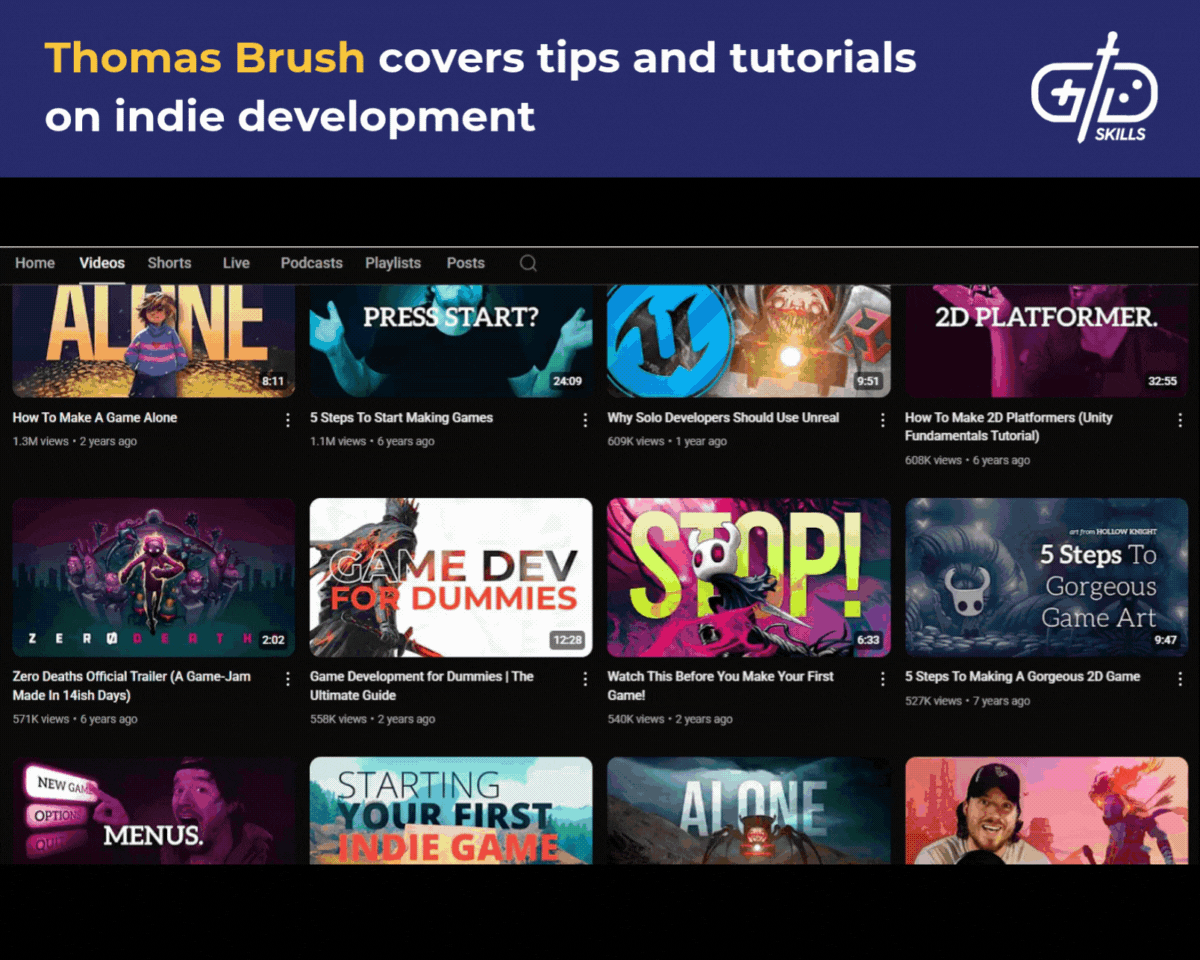
Brush is a developer who’s shipped commercially successful games. His YouTube channel gives a games-as-a-business take on the industry as much as it gives advice on creative and design work. Many channels cover topics like engines, tools, scripting, etc. Thomas’s discussion on business, marketing, and revenue are an underrepresented but crucial element of the industry. Brush’s transparency in how he built his indie career is inspiring for up-and-coming devs and helps them to avoid common pitfalls and mistakes.
Thomas Brush’s YouTube channel currently has over six hundred videos with over thirty million combined views and four hundred thousand subscribers. Brush likely makes some income from ad revenue while also promoting his courses and training products. Brush’s studio, Atmos Games, has several commercially available games which the YouTube channel raises awareness of. The channel also has a Patreon which helps support the production of new episodes.
13. BadGameDev
The BagGameDev YouTube channel isn’t explicitly a tutorial or advice channel despite its host discussing how he creates his own games. The channel focuses on offbeat topics and thought experiments. Previous episodes include concepts like “I Made Minecraft, but it’s a Horror Game”, “I remade my 2D Game, but it’s 3D”, and other wacky ideas.
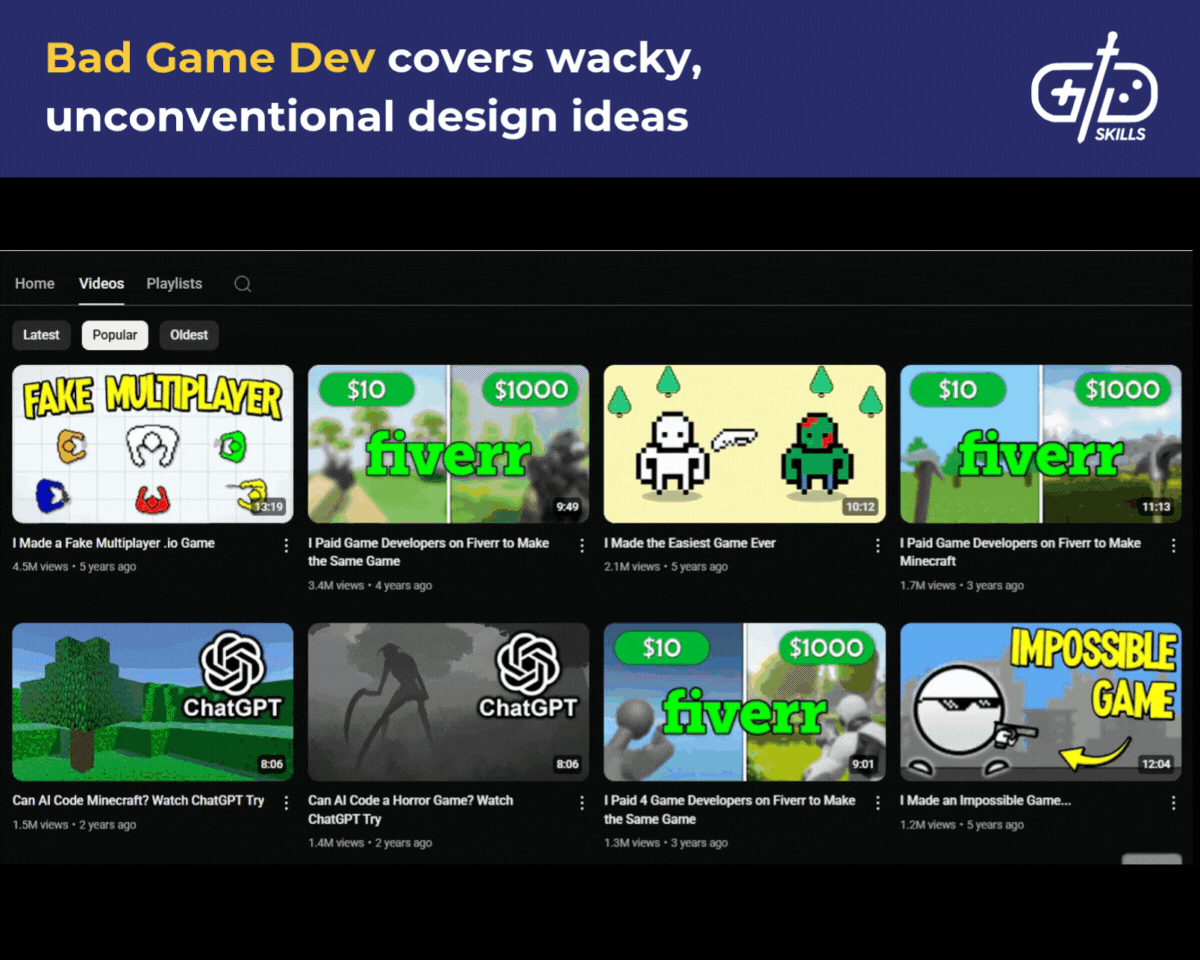
Watch BadGameDev as a palette cleanser after watching too much straight-laced tutorial content. BadGameDev’s content isn’t devoid of educational/instructional material, it just narrows down its focus to thought experiment-style videos. The host reimagines popular games in other genres and perspectives, often breaking the game in the process. It’s entertaining to watch a developer turn a popular title like Among Us into a battle royale game, for example. The “What happens if I try this wacky idea?” format is common in other YouTube niches. BadGameDev brings this format to gaming content.
BadGameDev has over two hundred thousand subscribers and fifty six videos that rack up hundreds of thousands of views. The high viewer numbers suggest BadGameDev makes ad revenue. A Patreon page connects donations to fun further videos. Many of the experimental and wacky games created for the project are available for free at the BadGameDev website.
14. DevDuck
DevDuck is a YouTube channel run by a software developer by day, indie developer by night called Ben. Ben created the channel in 2019 to share his insights into creating indie projects, developing apps, and balancing these projects with life. DevDuck topics often focus on the process of creating an indie game from the ground up. Examples include, “Building 2D RPG Exploration” and “My Game Dev Journey”.
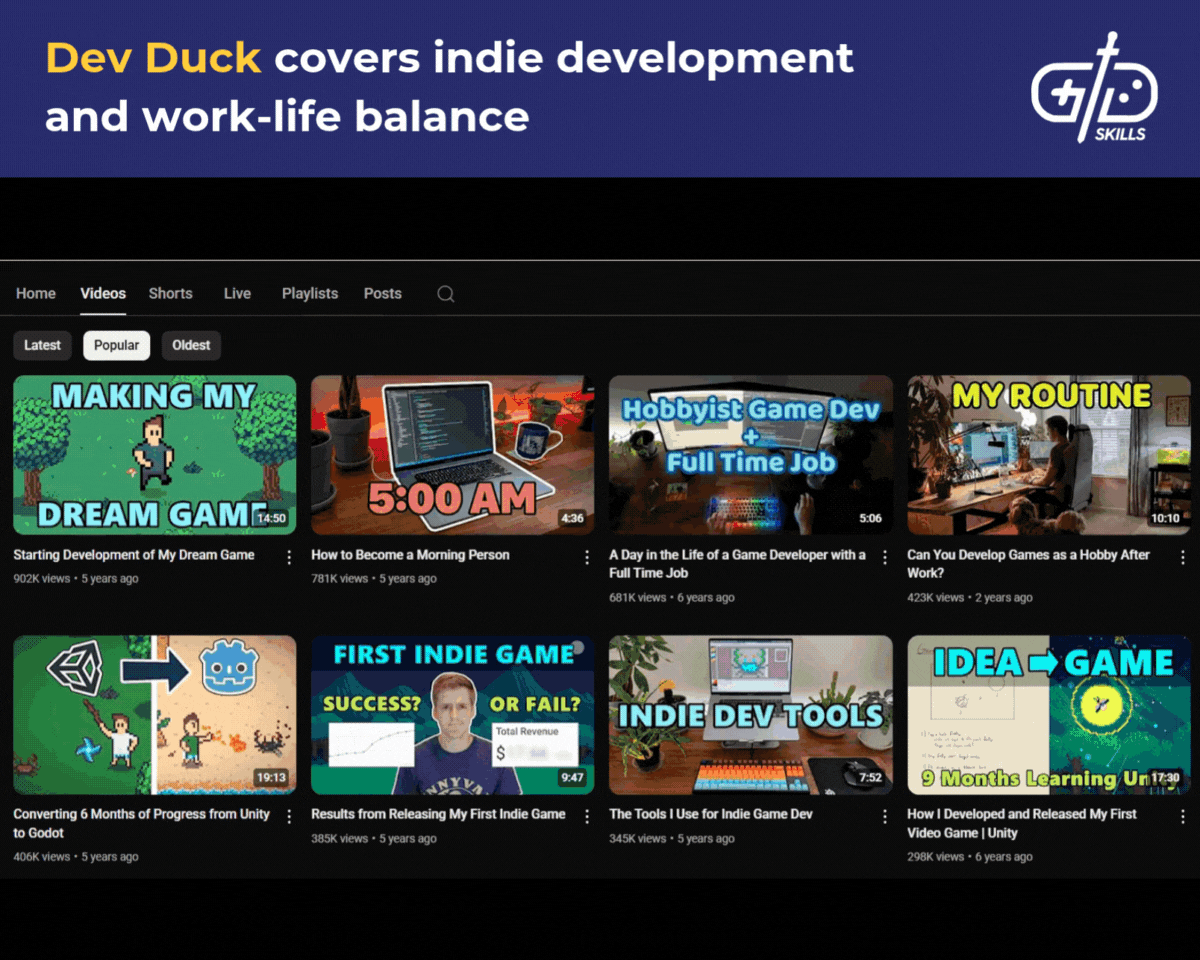
The path of working a day job while pursuing a passion for games is familiar to many up-and-coming indie devs. Ben’s discussions and insights are relatable to anyone who’s held down a job while trying to pursue creative work after hours. DevDuck does feature tutorial content and share code that works in his projects, but the mix of technical and personal makes it stand out.
DevDuck has over one hundred and thirty videos with a combined viewer total of over ten million. The channel has more than one hundred and seventy thousand subscribers. The high viewer count suggests some ad revenue. A Patreon page helps to support the creation of videos, and the DevDuck website sells games and apps the host has created.
15. Heartbeast
The Heartbeast YouTube channel makes content around Godot, GameMaker, and pixel art. The channel was created in 2013 and its host primarily focuses on tutorial series, engine deep dives, interviews, and documenting the process of making his own projects. Examples include “Make an Action RPG in Godot”, and “2D Hack-n-Slash Course”.
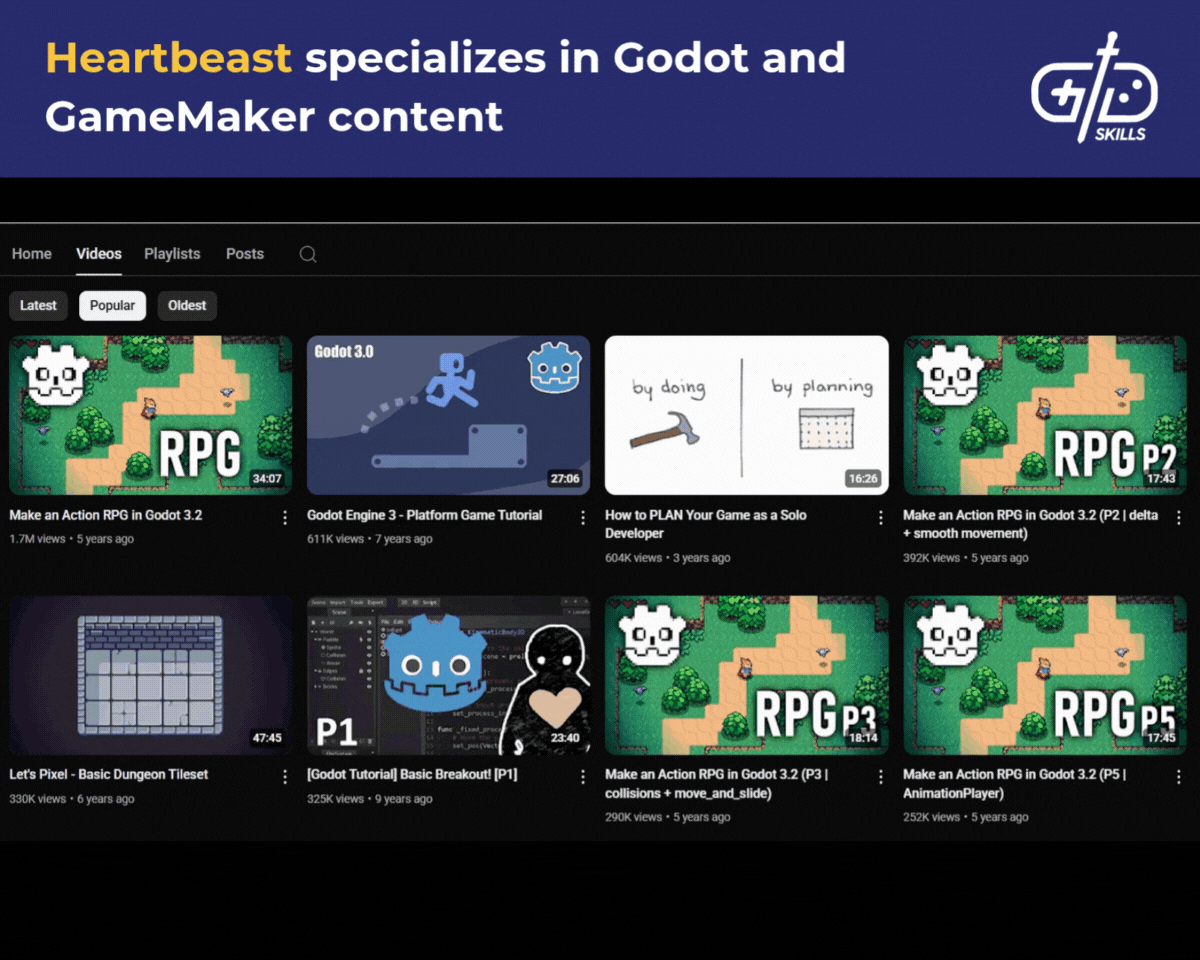
Watch Heartbeast for his Godot (and previously GameMaker) specialization. His videos are useful for devs just starting their Godot journey, but also include information for more experienced developers. Heartbeast’s structured series help first time devs run through the processes detailed for the first time. The channel’s mix of code and pixel art make it stand out.
The Hearbeast channel hosts over one hundred and seventy videos with a combined viewer count of over eleven million. The channel has over two hundred and forty thousand subscribers. The channel acts as advertising and proof of concept for Heartbeast’s paid courses. He also sells games and demos on itch.io.
16. Noclip
Noclip is a YouTube channel hosted by Danny O’Dwyer in 2016 to make high-quality video game documentaries and content. The idea for the channel was to have the content entirely funded through Patreon rather than ads. Noclip’s focus is on long form making of-style content discussing the development of particular games, studios, or genres. Examples include “The Making of Pentiment” and “Design of Dredge”.
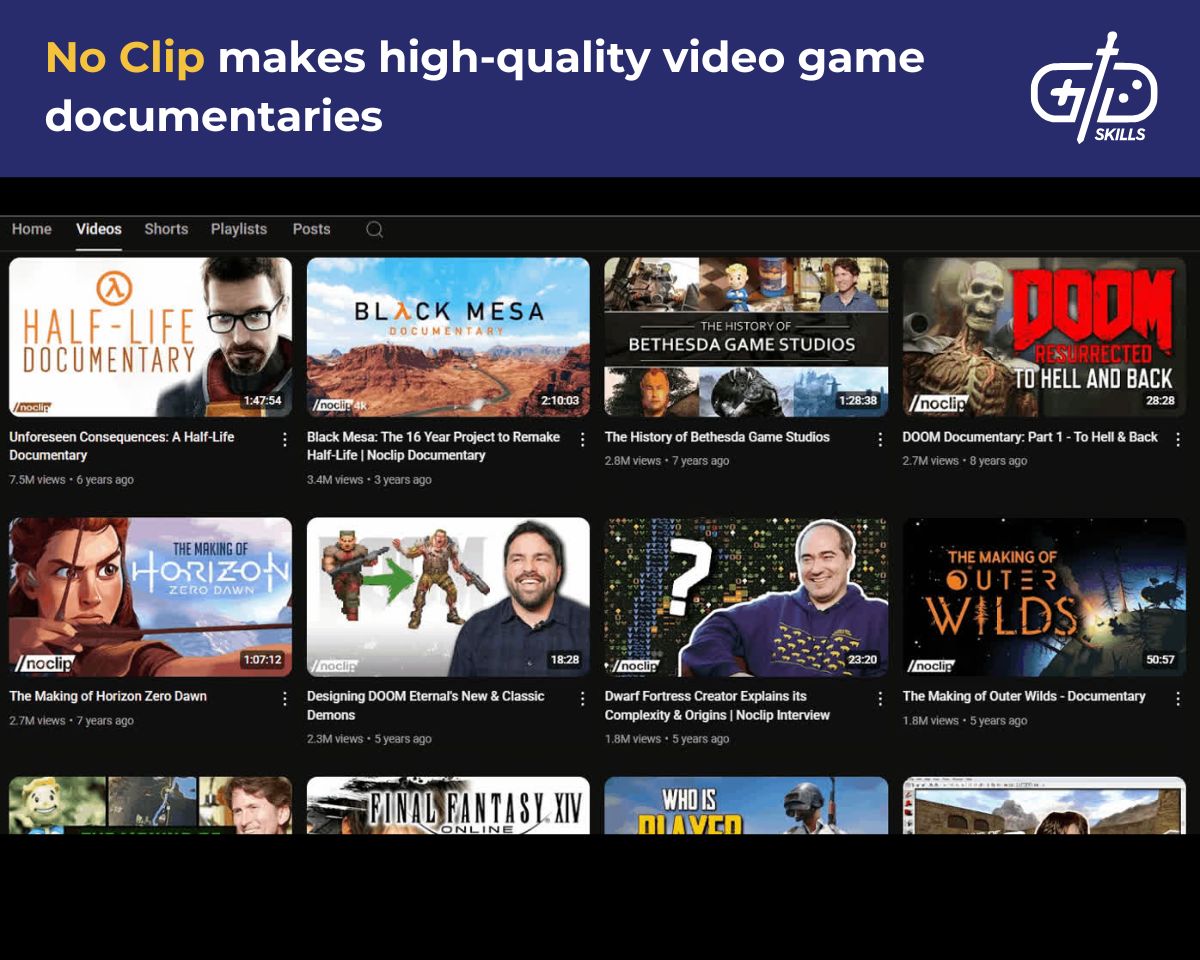
Noclip’s high production values and in-depth analysis of beloved games make it worth watching. The channel’s reputation for quality content means they often have access to studio staff for insights other outlets don’t get. Noclip are also clear that they retain total editorial control, meaning the studios featured don’t get to alter or censor any content they disapprove of.
The Noclip YouTube account has over eight hundred thousand subscribers. The channel’s two hundred and twenty videos have amassed millions of views. Funding for Noclip is achieved through Patreon. This gives the creators freedom to work independently and gives its audience input into what is covered on the channel. Noclip also has a merch store and accepts donations on their website.


